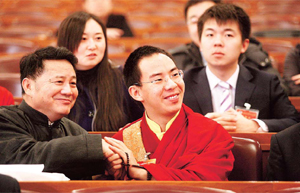Full text: Report on national economic, social development
(Xinhua)
Updated: 2010-03-16 14:14
6. Reform and opening up continued to deepen.
We made new progress in reforming key areas and crucial links. We promoted the expansion of rural reforms. The reform of tenure in collective forests was extended nationwide, and the rights on 100 million hectares of collective forests (60% of the country's total) were devolved to rural residents. New steps were taken in the reform of enterprises. The 142 central state-owned enterprises (SOEs) at the beginning of 2009 were restructured into 129, and we extended the pilot project for standardizing boards of directors to 24 central SOEs. We basically completed asset and business restructuring in relevant enterprises of the basic telecommunications industry, and the competition pattern in the 3G telecommunications market took shape. We formulated and implemented the guidelines for further promoting the development of small and medium-sized enterprises and formulated policies and measures to encourage and guide investment from non-government sources, thereby expanding market access, lowering the market entry threshold, broadening the channels of financing and improving the investment environment. We achieved positive results in fiscal, tax and financial reforms. We comprehensively rolled out VAT reform. We made smooth progress in reforming prices of refined petroleum products and related taxes and fees and rescinded six kinds of fees, including the road maintenance fee. We continued to deepen the reform of financial institutions and capital markets, launched the ChiNext stock market, made steady progress in transforming the China Development Bank into a commercial institution and the Agricultural Bank of China into a shareholding company, and began trials of RMB settlements in cross-border trade. We continued to deepen reform of the investment system, continue to review the items subject to examination and approval for investment projects, and improved the way in which the government arranges and manages its investment plans. The reform of prices for resource products and environmental protection charges moved forward steadily. We conducted the trial of direct trade between electricity users and power plants. We began comprehensively expanding the reform of the pharmaceutical and health care system, promulgated the plan for implementing the reform and 15 relevant documents, and made orderly progress in key areas, such as developing the system of basic medical insurance, implementing the national system for basic drugs, improving the community-level medical and health care system, and promoting equal access to basic public health services. We implemented the reform to introduce a performance-based salary system in schools providing compulsory education, and in public health institutions and community-based medical and health care institutions, and steadily pressed ahead with institutional reforms in culture, the press and publishing. Work on experimental zones for integrated, complete reform progressed in an orderly manner.
We achieved positive results in opening up. We raised export rebate rates four times for labor-intensive products and technology-intensive, high value-added products under 6,955 HS codes; cancelled or lowered 102 export tariffs on grain, fertilizers and selected industrial products; adjusted and reduced 1,804 items on the list of commodities whose processing is classified as prohibited or subject to some restrictions in the processing trade; took active steps to address trade frictions; and effectively eased the adverse impact of drastic changes in the external environment. Drops in imports and exports gradually slowed and both returned to growth at the end of the year. Total import and export volume reached US$2.20722 trillion in 2009, including exports of $1.20166 trillion and imports of $1.00556 trillion. This figure dropped 13.9% compared to the previous year, and failed to meet the targeted growth rate of 8% -- a failure resulting from the sharp decline in international demand, the drop in global market prices, as well as the comparatively low grades of our export products. We continued to adjust the structure of foreign investment utilization. We promulgated and implemented the Suggested List of Industries that Can Take Advantage of Local Strengths in the Central and Western Regions for Foreign Investment in order to lead foreign investment toward high-tech industries, high-end manufacturing and R&D as well as resource-conserving and environmentally friendly industries. Last year, foreign direct investment (excluding that in the banking, securities and insurance sectors) totaled $90 billion, $2.4 billion less than planned. China' s foreign exchange reserves stood at $2.3992 trillion at the end of 2009, an increase of $453.1 billion year on year. Outbound investment cooperation soared despite the financial crisis, with new progress made in joint exploitation of energy and resources, overseas mergers and acquisitions, contracted projects and labor services. Chinese direct investment (excluding financial sector investment) in other countries reached $43.3 billion in 2009, an increase of 6.5%, and the volume of business in overseas contracted projects amounted to $77.7 billion, an increase of 37.3%.


